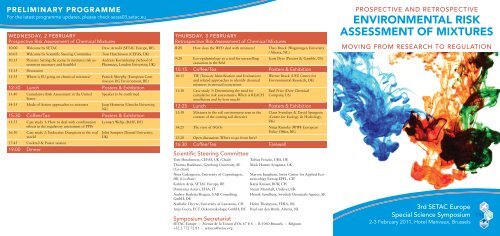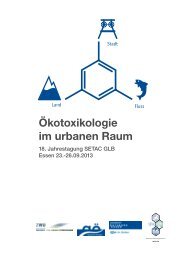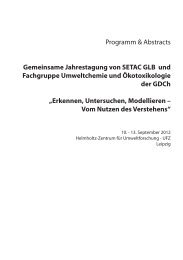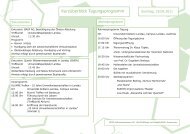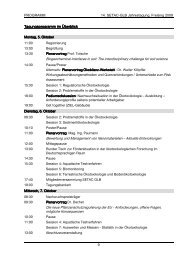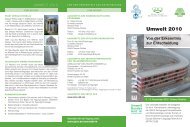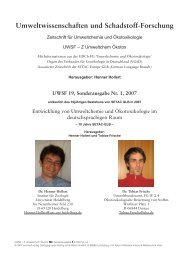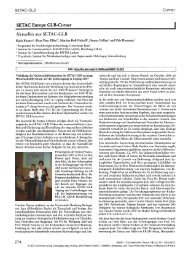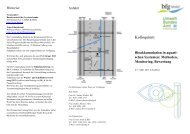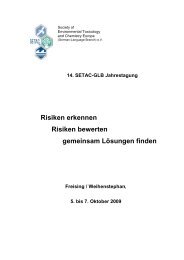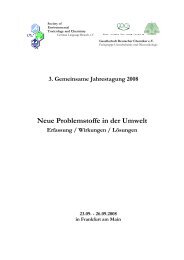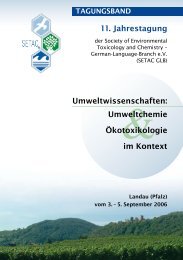ENVIRONMENTAL RISK ASSESSMENT OF MIXTURES - Setac GLB
ENVIRONMENTAL RISK ASSESSMENT OF MIXTURES - Setac GLB
ENVIRONMENTAL RISK ASSESSMENT OF MIXTURES - Setac GLB
You also want an ePaper? Increase the reach of your titles
YUMPU automatically turns print PDFs into web optimized ePapers that Google loves.
Preliminary programme<br />
For the latest programme updates, please check sesss03.setac.eu<br />
Wednesday, 2 February<br />
Prospective Risk Assessment of Chemical Mixtures<br />
10:00 Welcome by SETAC Dave Arnold (SETAC Europe, BE)<br />
10:05 Welcome by Scientific Steering Committee Tom Hutchinson (CEFAS, UK)<br />
10:15 Plenary: Setting the scene: Is mixtures risk assessment<br />
necessary and feasible?<br />
11:15 Discussion<br />
Andreas Kortenkamp (School of<br />
Pharmacy, London University, UK)<br />
11:35 Where is EU going on chemical mixtures? Patrick Murphy (European Commission<br />
DG Environment, BE)<br />
12:30 Lunch Posters & Exhibition<br />
13:40 Cumulative Risk Assessment in the United Speaker to be confirmed<br />
States<br />
14:35 Mode of Action approaches to mixtures Joop Hermens (Utrecht University,<br />
NL)<br />
15:30 Coffee/Tea Posters & Exhibition<br />
15:55 Case study 1: How to deal with combination<br />
effects in the regulatory assessment of PPPs<br />
16:50 Case study 2: Endocrine Disruptors in the real<br />
world<br />
17:45 Cocktail & Poster session<br />
19:00 Dinner<br />
Lennart Weltje (BASF, DE)<br />
John Sumpter (Brunel University,<br />
UK)<br />
Thursday, 3 February<br />
Retrospective Risk Assessment of Chemical Mixtures<br />
8:25 How does the WFD deal with mixtures? Theo Brock (Wageningen University<br />
/ Alterra, NL)<br />
9:20 Eco-epidemiology as a tool for unravelling<br />
causation in the field<br />
Scott Dyer (Procter & Gamble, US)<br />
10:15 Coffee/Tea Posters & Exhibition<br />
10:35 TIE (Toxicity Identification and Evaluation)<br />
and related approaches to identify chemical<br />
mixtures in stressed ecosystems<br />
11:30 Case study 3: Determining the need for<br />
cumulative risk assessments: When is REACH<br />
insufficient and by how much?<br />
Werner Brack (UFZ Centre for<br />
Environmental Research, DE)<br />
Paul Price (Dow Chemical<br />
Company, US)<br />
12:25 Lunch Posters & Exhibition<br />
13:30 Mixtures in the soil environment seen in the<br />
context of the coming soil directive<br />
Claus Svendsen & David Spurgeon<br />
(Centre for Ecology & Hydrology,<br />
UK)<br />
14:25 The view of NGOs Ninja Reineke (WWF European<br />
Policy Office, BE)<br />
15:20 Open discussion: Where to go from here?<br />
16:30 Coffee/Tea Farewell<br />
Scientific Steering Committee<br />
Tom Hutchinson, CEFAS, UK (Chair)<br />
Thomas Backhaus, Göteborg University, SE<br />
(Co-chair)<br />
Nina Cedergreen, University of Copenhagen,<br />
DK (Co-chair)<br />
Katrien Arijs, SETAC Europe, BE<br />
Domenica Auteri, EFSA, IT<br />
Audrey Barletta-Bergan, GAB Consulting<br />
GmbH, DE<br />
Nathalie Chevre, University of Lausanne, CH<br />
Anja Coors, ECT Oekotoxikologie GmbH, DE<br />
Tobias Frische, UBA, DE<br />
Mick Hamer, Syngenta, UK<br />
Marion Junghans, Swiss Center for Applied Ecotoxicology<br />
Eawag-EPFL, CH<br />
Katja Knauer, BLW, CH<br />
Stuart Marshall, Unilever, UK<br />
Henrik Sundberg, Swedish Chemicals Agency, SE<br />
Helen Thompson, FERA, UK<br />
Paul van den Brink, Alterra, NL<br />
Symposium Secretariat<br />
SETAC Europe 0 Avenue de la Toison d’Or, 67 b 6 0 B-1060 Brussels 0 Belgium<br />
+32 2 772 72 81 0 setaceu@setac.org<br />
Prospective and Retrospective<br />
Environmental Risk<br />
Assessment of Mixtures<br />
Moving from Research to Regulation<br />
3rd SETAC Europe<br />
Special Science Symposium<br />
2-3 February 2011, Hotel Marivaux, Brussels
Prospective and Retrospective Environmental<br />
Risk Assessment of Mixtures: Moving from<br />
Research to Regulation<br />
Registration<br />
You can register for the symposium online via sesss03.setac.eu. Please note, registration is limited<br />
to 135 participants on a first come, first served basis.<br />
If you register and pay before 1 November, you will benefit from a € 150 reduction on the registration<br />
fee.<br />
Chemical-analytical surveys demonstrate over and over again, that organisms in the environment<br />
are exposed to complex chemical cocktails. Also chemical products, for example pesticides or<br />
surfactants, are usually combination products comprising active ingredients, preservatives, filling<br />
agents, etc.. However, the environmental effects of chemicals are traditionally evaluated and regulated<br />
on the basis of single substances, chemical by chemical. There seems to be a developing consensus<br />
that this approach is not sufficient, especially because the toxicity of a mixture of chemicals<br />
is usually higher than each of the individual substances.<br />
In December 2009 the EU environment ministers therefore asked the European Commission to<br />
strengthen its work on managing the risks posed by chemical mixtures. In parallel, a range of<br />
reviews, guidelines and recommendations on how to assess risks of chemical mixtures have been<br />
compiled by academic working groups as well as national, European and international bodies (e.g.<br />
WHO or EFSA).<br />
The symposium will present a unique overview and debate on the current state of the art, the open<br />
questions and the latest developments with respect to the environmental risk assessment of mixtures.<br />
Leading experts from academia, industry, regulatory authorities and NGOs will identify key<br />
issues and discuss recommendations for future research and regulation.<br />
Approaches to mixture risk assessment will be discussed<br />
from a retrospective as well as a prospective perspective.<br />
Retrospective approaches are implemented as Toxicity Identification and Evaluation<br />
(TIE) and eco-epidemiological studies. They aim mainly at identifying causes for observed<br />
impacts, for example in a polluted river or at a waste disposal site. Prospective studies on the other<br />
hand focus on the prediction of mixture toxicities, based on the toxicological or ecotoxicological<br />
properties of its components, which is needed for the setting of Predicted No-Effect Concentrations<br />
(PNECs) or similar environmental quality endpoints. In both types of studies, the classical mixture<br />
concepts of Independent Action (Response Addition) and Concentration (or Dose) Addition play<br />
a pivotal role. The concepts are mode of action driven and provide a frame of reference in which<br />
to evaluate the joint action of toxicants and are hence also centerpieces in all current regulatory<br />
guidelines on mixture toxicities. However, several open questions still remain that will be examined<br />
by the symposium speakers. These range from fundamental scientific issues on the applicability of<br />
the concepts for various mixture types and exposed organisms, to matters concerning the implementation<br />
of the mixture perspective into existing regulatory frameworks and to the development<br />
of appropriate environmental quality targets for chemical mixtures. The symposium aims to target<br />
regulatory frameworks such as REACH, the Water Framework Directive, the pesticide and biocide<br />
directives.<br />
Who will benefit from this conference?<br />
ŊŊ<br />
Risk assessors and researchers from industry, government and academia.<br />
ŊŊ<br />
Contract research organisations and consultants offering services related to chemical risk assessment.<br />
Why attend?<br />
ŊŊ<br />
Get up to the minute information on the state of the art and recent developments on the environmental<br />
hazard and risk assessment of chemical mixtures.<br />
ŊŊ<br />
Learn from and contribute to panel discussions with the speakers.<br />
ŊŊ<br />
Be part of a great networking opportunity enabling face to face discussion with experts.<br />
ŊŊ<br />
Play a part in the implementation process of mixture toxicity into regulation.<br />
Through 31 October<br />
After 31 October<br />
SETAC member € 590 € 740<br />
Non-member € 740 € 890<br />
SETAC student member* € 250 € 250<br />
*Student registration fees are ONLY available to SETAC student members who submit an abstract<br />
for poster presentation at the symposium<br />
Go to www.setac.org to join SETAC and benefit from € 150 reduction on your registration fee.<br />
Registration fees include attendance at the two day symposium, buffet lunch each day, morning<br />
and afternoon coffee breaks, a cocktail reception the evening of the first day and the symposium<br />
dinner. Hotel accommodation and breakfast are not included. The symposium will be conducted in<br />
the Marivaux hotel (www.marivaux.be) in the centre of Brussels.<br />
Posters<br />
We welcome the submission of abstracts for posters at this symposium which will be evaluated<br />
by the steering committee. Ample time will be given during the syposium for authors to discuss<br />
their work on research related to the theme of the symposium. Please note, that your contribution<br />
should be focused on the value of your research for the possible implementation of mixture toxicity<br />
into regulatory frameworks. Submit your poster abstract online via sesss03.setac.eu before 15<br />
November 2010.<br />
Exhibition<br />
SETAC Europe invites exhibitors from contract research laboratories, research institutes, and<br />
consultancies to promote their services at this symposium. Details can be found on the website<br />
(sesss03.setac.eu).<br />
Sponsorship Opportunities<br />
If your organisation is seeking either to promote its specialisms in relation to the symposium<br />
theme or to demonstrate support for SETAC, then there is an opportunity for you to sponsor this<br />
meeting. You will be recognised on symposium literature, on the symposium website and on any<br />
post symposium publications. You may also specify sponsorship such as contributions to research<br />
student attendance at the meeting.<br />
For details either see the symposium website (sesss03.setac.eu) or contact the SETAC Europe office.<br />
For more information, go to sesss03.setac.eu or contact the SETAC Europe office.<br />
SETAC Europe 0 Avenue de la Toison d’Or 67 b 6 0 B-1060 Brussels 0 Belgium<br />
+32 2 772 72 81 0 setaceu@setac.org


